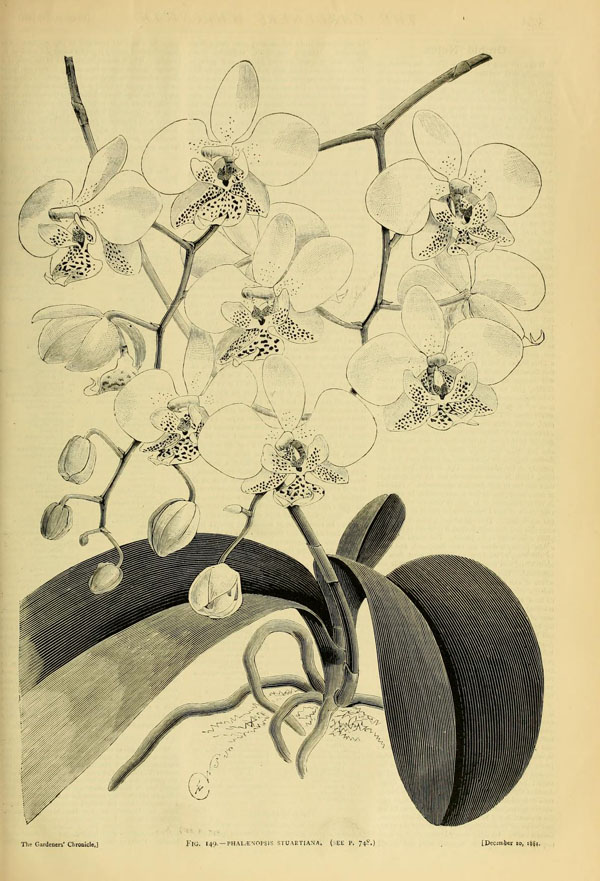
We have to mark one of the best of red-letter days in the orchidic calendar. Phalaenopsis Stuartiana, named in July last in honour of Mr. Stuart Low, of the old firm of Hugh Low & Co., my oldest English correspondent, is now in flower at Upper Clapton. It supplies quite fresh colours to a shape like that of Phalaenopsis Schilleriana, and will remarkably improve the ensemble of a fine Phalaenopsis collection.
I learn from Mr. Low's letter that the roots are flat (whether rough or smooth I do not know). The young leaves are nicely marbled, but as they get older the marbling vanishes to a great extent. The inflorescence is a many flowered panicle, so full of flower that Mr. Boxall, the lucky discoverer, counted as many as 120 on the panicle of a three-leaved plant. Having obtained the dried flowers last July I cannot think living plants were previously in Europe, but now, at the end of November, the flowers appear on the scene.
Those flowers belong, as I stated before, to the affinity of Phalaenopsis Schilleriana, having similar anchor-like tails. I obtained a nice lot of dried specimens, and a good many of these rival those of Phalaenopsis amabilis in size, but the fresh ones at hand are smaller, as might be expected in the case of first flowers. They are of a delightful colour, like the best Devonshire cream. The sepals are outside of a light sulphur, and inside the inferior halves of the lateral sepals are of the same colour, with dark cinnamon blotches. The side laciniae of the lip are pure white at the top, but with that exception orange as the callus, and the central lacinia is light sulphur-coloured, with white borders and white tails. All those parts, as far as they are yellow or orange, are covered with dark cinnamon blotches. A variety I propose to name Phalaenopsis Stuartiana nobilis is longer in all the parts of flower, the anterior lacinia of the lip is rhombic, and the whole flower is sulphur-yellow, except the callus, which is orange. There are a few small mauve spots on the petals. I do not know whether they are constantly developed.
When looking at this fresh, young, and grand beauty I had a vague impression as to its resemblance to something I had seen, but which I could not define ; finally, however, I came to the point. It was the lip of Coelogyne (Pleione) Arthuriana and of C. maculata. The white Phalaenopsis has the orna- ments of those glorious gems.
Is the plant a natural hybrid? I remember an English orchidist who told me in confidence that all these hybrids originated with dear Thomas Lobb, who amused himself by crossing Orchids. I should not like to enter upon guesses myself, the more as my excellent correspondent, Mr. Stuart Low, forgot to give me the exact locality for publication, and did not reveal to me all the details about the plant's neighbours, circumstances, &c. : at all events we may be pretty sure, when regarding Phalaenopsis Stuartiana, that it is a tropical Asiatic plant. No doubt there will be a great pilgrimage to Upper Clapton to see the fresh beauty under that mighty expanse of glass which forms the theatre of Lowian activity. H. G. Rchb. f.
* Phalaenopsis stuartiana, n sp. - Radicibus depressis ; foliis juventute marmoratis dein aequaliter coloratis ; panicula multiflora ; callo stipitato didymo basi extrorsum acuminato-subulato intus bidentato sulcato, callo in laciniis lateralibus obscurissimo. Flores ceterum Phalaenopsidis Schillerianae - Flos lacteus. Sepala lateralia antice sulphurea cinnamomeo-maculata. Labellum, exceptis apicibus summis laciniarum lateralium, margine et caudis laciniae anticae albis, flavum maculis que plurimis cinnamomeis. H. G. Rchb. f.


